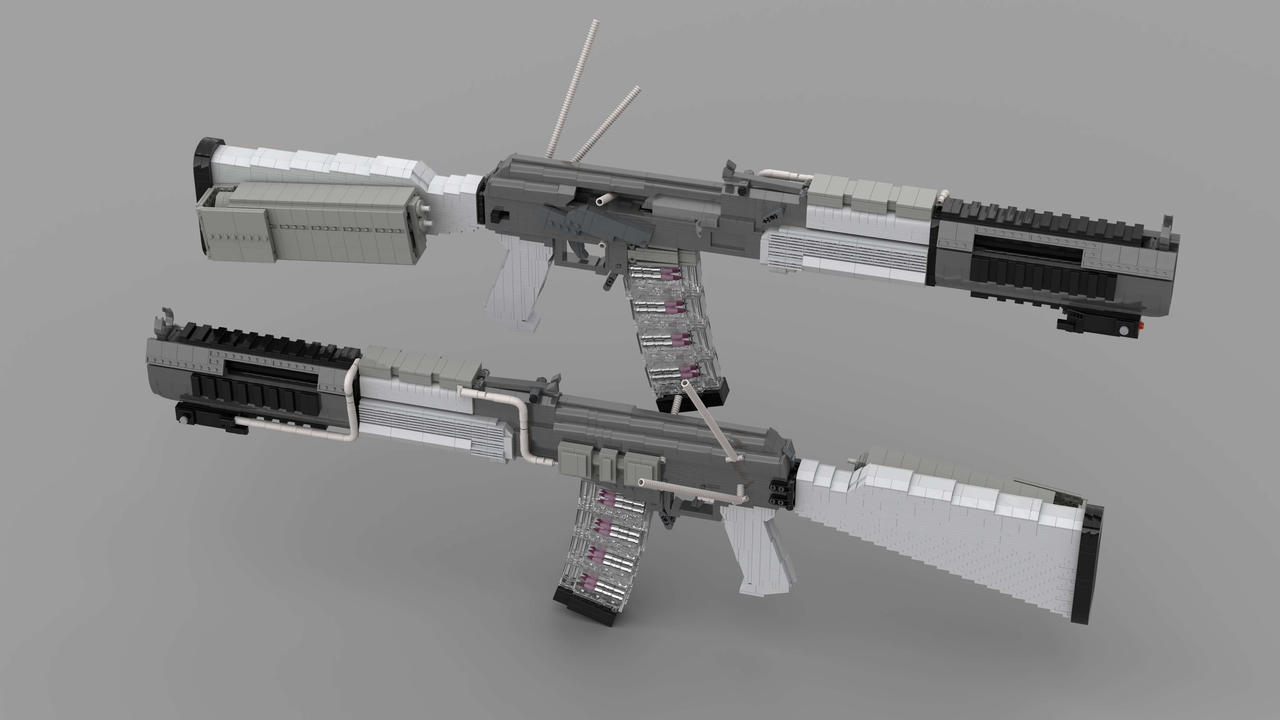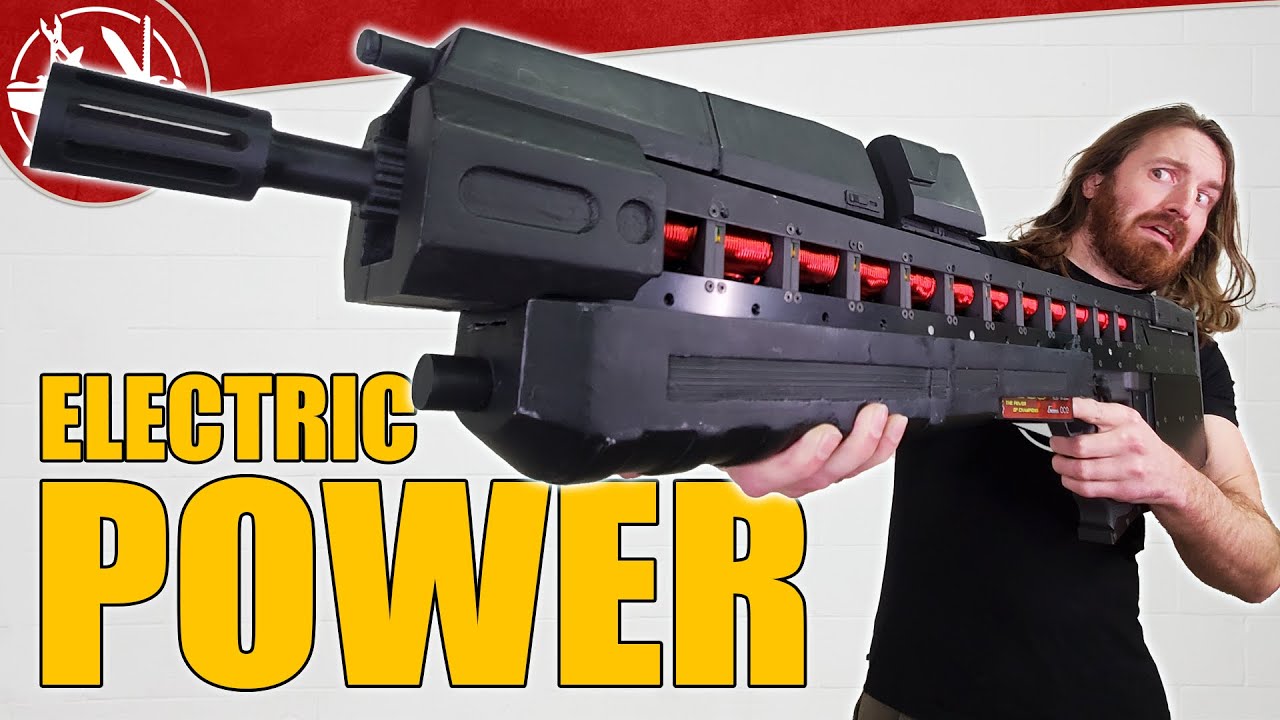Real Rail Gun - A rail gun or rail gun is a linear motor device, usually designed as a gun, that uses electromagnetic force to fire high-velocity projectiles. The projectile does not normally contain explosives, but instead relies on the high velocity, mass, and kinetic energy of the projectile to cause damage.
The railgun uses a pair of parallel conductors (rails) along which a sliding armature is accelerated by the electromagnetic effects of an umbilical traveling along one rail, through the armature, and back along the other rail. It is based on principles similar to those of the homopolar motor.
Real Rail Gun

Since 2020, railguns have been studied as weapons that use electromagnetic forces to impart very high kinetic energy to a projectile (e.g. APFSDS) instead of using conventional propellants. While military high-explosive weapons cannot easily achieve a muzzle velocity of more than ≈2 km/s (5.9 Mach), railguns can easily exceed 3 km/s (8.8 Mach). For a similar projectile, the range of railguns can exceed that of conventional guns. The destructive force of a projectile depends on its kinetic energy (the mass of the projectile multiplied by its speed squared, divided by 2) at the point of impact. Due to the potentially higher velocity of a rail-launched projectile, its force can be much greater than that of a conventionally-launched projectile of the same mass. The lack of explosive propellants or warheads to store and handle, as well as the low cost of the projectiles compared to conventional weapons, are also advantageous.
Unlock The Railgun (gta Online And Gta 5 Story Mode)
Railguns are still in the research stage after decades of research and development, and it remains to be seen whether they will be deployed as practical military weapons for the foreseeable future. Any analysis of the trade-off between electromagnetic (EM) propulsion systems and chemical propellants for weapons applications must also consider its durability, availability, and economy, as well as novelty, scale, of the high power demand and the complexity of the pulsed power supply. which are needed. for electromagnetic trigger systems.
In that no additional field coils (or permanent magnets) are used. This basic configuration is formed by a single mushroom loop and therefore requires high turns (eg, on the order of a million amperes) to produce sufficient accelerations (and muzzle velocity). A relatively common variant of this configuration is the augmented rail in which the drive wheel is routed through additional pairs of parallel conductors, arranged to increase ("augmt") the magnetic field experienced by the drive armature.
These adjustments reduce the current needed for a given acceleration. In electric motor terminology, boost guns are generally series-wound configurations. Some railguns also use powerful neodymium magnets with the field perpendicular to the current flow to increase the force on the projectile.
Armor can be an integral part of the projectile, but it can also be configured to accelerate a separate, electrically isolated, or non-conductive projectile. Solid metal sliding conductors are often the preferred form of railgun armor, but plasma or "hybrid" armor can also be used.
How To Master The New Rorsch Mk 4 Railgun
A plasma armature is formed by an arc of ionized gas used to propel a solid, non-conductive charge in a manner similar to the pressure of propellant gas in a conventional weapon. Hybrid armor uses a pair of plasma contacts to interface metal armor with the barrel rails. Solid armor can also "switch" to hybrid armor, usually after exceeding a certain speed threshold. The high torque required to power a railgun can be provided by various power supply technologies, such as capacitors, pulse generators, and disk generators.
For potential military applications, railguns are generally attractive because they can achieve much higher muzzle velocities than weapons powered by conventional chemical propellants. Increased muzzle velocities with more aerodynamic projectiles can bring the benefits of increased firing range while, in terms of target effects, increased terminal velocities can enable the use of kinetic energy shells that incorporate dart guidance. impact for kills, as substitutes for HE shells. Therefore, typical military firearm designs target muzzle velocities in the range of 2,000–3,500 m/s (4,500–7,800 mph; 7,200–12,600 km/h) with muzzle energies of 5 at 50 megajoules (MJ). For comparison, 50 MJ is equivalent to the kinetic energy of a school bus weighing 5 metric tons traveling at 509 km/h (316 mph; 141 m/s).
For single-loop railguns, these mission requirements require a release current of several million amperes, so a typical railgun power supply can be designed to provide a release surge of 5MA for several milliseconds. Since the magnetic field strengths required for such launches will typically be around 10 tesla (100 kilogauss), most contemporary railgun designs are effectively air-core, i.e. 'they do not use ferromagnetic materials such as iron to increase the magnetic flux. However, if the barrel is made of a magnetically permeable material, the strength of the magnetic field increases due to the increased permeability (μ = μ

Railgun velocities are within the range of those achievable by light two-stage gas guns; however, the latter are generally considered suitable only for laboratory use, while railguns are considered to offer potential prospects for development as military weapons. A light gas pistol, the Light Gas Combustion Pistol in prototype 155mm form was expected to achieve 2,500m/s with a 70 caliber barrel.
Another Look At The Us Navy's Electromagnetic Railgun That Fires Projectiles At Mach 7
In some hypervelocity research projects, the projectiles are 'pre-injected' into railguns, to avoid the need for a standing start, and two-stage light gas guns and powder guns conventional were used for this role. In principle, if rail power supply technology can be developed to provide safe, compact, reliable, combat-resistant and lightweight units, the total system volume and mass required to accommodate such power and fuel supply could become lower than required. total volume and mass for a mission-equivalent amount of conventional propellants and high-explosive ordnance. Perhaps such technology matured with the introduction of the Electromagnetic Aircraft Launching System (EMALS) (although railguns require much higher system powers as roughly similar energies must be delivered in milliseconds, as opposed to seconds). Such a development would confer an additional military advantage in that the removal of explosives from any military weapons platform would reduce its vulnerability to enemy fire.
The concept of the railgun was first introduced by French inventor André Louis Octave Fauchon-Villeplée, who created a small working model in 1917 with the help of the anonymous Tudor Accumulator Society (now Tudor Batteries ).
During World War I, Jules-Louis Breton, French Director of Invtions at the Ministry of Armaments, commissioned Fauchon-Villeplee to develop a 30 mm to 50 mm electric cannon on July 25, 1918, after delegates from the Commission of Invtions witnessed trials of the working model in 1917. However, the project was abandoned after the end of World War I later that year on November 11, 1918.
Fauchon-Villeplee filed an American application on April 1, 1919, which was published in July 1922 as patt no. 1, 421, 435 "Electrical apparatus for moving projectiles".
Emg F4 Defense Licensed F4 15 Ars L Mlok M4 Airsoft Aeg Rifle (model: Pdw / Black / Go Airsoft Package), Airsoft Guns, Airsoft Electric Rifles
In his device, two parallel bands are attached to the arms of a projectile, and the entire device is surrounded by a magnetic field. When current passes through the bars and the projectile, a force is induced which propels the projectile along the bars and into flight.
In 1923 the Russian scientist A. L. Korol'kov detailed his criticisms of Fauchon-Villeplee's design, challenging some of Fauchon-Villeplee's claims about the benefits of his invitation. Korol'kov eventually concluded that while building a long-range railgun was within the realm of possibility, the practical implementation of the Fauchon-Villeplee railgun was hampered by its high power consumption and need for a special electric generator. with considerable capacity. to empower it.
In 1944, during World War II, Joachim Hänsler of the German Munitions Board proposed the first theoretically viable railway gun.

By late 1944, the theory behind its electric anti-aircraft gun had been developed sufficiently to allow the Luftwaffe's Flak Command to issue a specification, which called for a muzzle velocity of 2,000 m/s (4,500 mph; 7,200 km/h; 6.600 ft/s) and a shell containing 0.5 kg (1.1 lb) of explosive. The guns were to be mounted in six-round batteries of twelve rounds per minute, and the existing 12.8 cm FlaK 40 mounts were to be fitted. It was never built. The details revealed after the war generated much interest and more detailed study was undertaken, culminating in a 1947 report concluding that it was theoretically feasible, but that any weapon would need sufficient power to illuminate half from Chicago.
Railguns: All You Need To Know About The Weapon That Uses Electromagnetic Force
In 1950, Sir Mark Oliphant, an Australian physicist and first director of the Research School of Physical Sciences at the new Australian National University, began the design and construction of the world's largest homopolar generator (500 megajoules).
This machine was operational from 1962 and was later used to power a full-scale railgun which was used as a science experiment.
In 1980, the Ballistics Research Laboratory (later consolidated to form the United States Army Research Laboratory) began a long-term program of theoretical and experimental railgun research. The work was primarily carried out at the Aberde Proving Ground, and much of the early research was inspired by railgun experiments carried out by the Australian National University.
As military research into firearms technology in the United States continued to pursue
Staccato C2 2011 Pistol 9mm Fullsize Optic Ready 4.5\
Colt rail gun holster, how to build a rail gun, navy rail gun video, rail system gun, colt 1911 rail gun holster, colt 1911 rail gun holsters, rail gun range, 1911 rail gun holster, what is a rail gun, nerf gun rail attachments, homemade rail gun, nerf rail gun
0 Comments